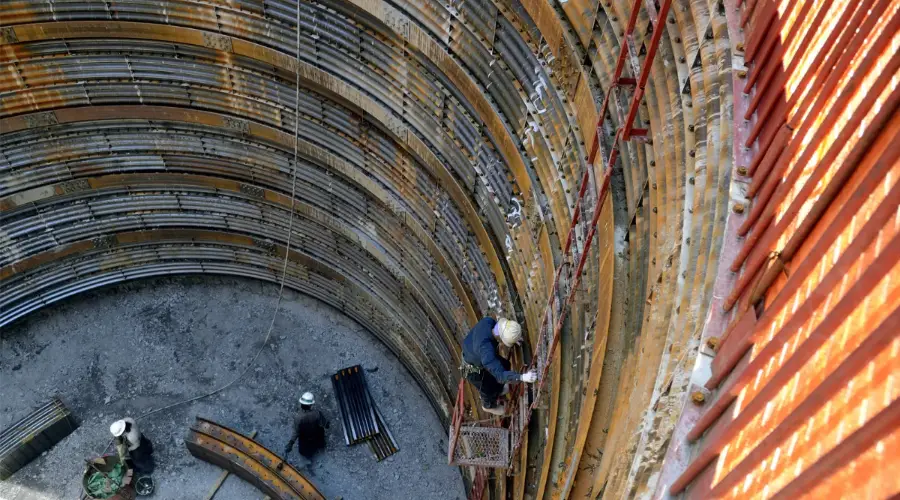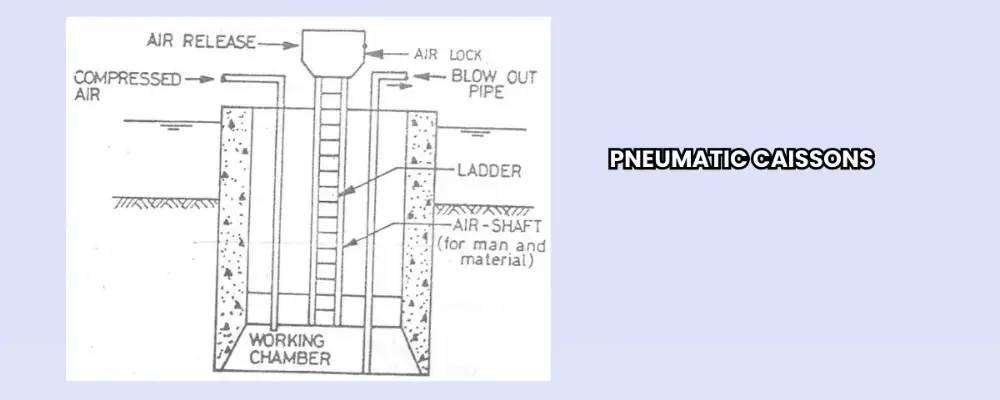One of the engineering marvels that we often see today are bridges spanning across large lengths. While talking about such bridges, a common question that arises is how the foundation and supports for these structures are built, especially in underwater conditions. The answer commonly lies in structures known as pneumatic caissons. Read on to learn all about pneumatic caissons that help construct some of the best projects in the modern world.
What are Pneumatic Caissons?
Pneumatic caissons are specialised construction structures required to create a strong foundation for buildings under water or in wet conditions. From a technical perspective, this structure is designed as a watertight, square-shaped enclosure that effectively prevents water from entering the construction zone. It serves as a barrier that completely safeguards the interior environment from the external wet conditions.
In general, a pneumatic caisson is used to build foundations of bridges, buildings, structures of sewage treatment facilities, underground railways and tunnels, and underground water regulating reservoirs.
How do Pneumatic Caissons Work?
Pneumatic caissons work on the principle of air pressure. When a cup is holding air inside and is pressed into water upside down, the air pressure keeps the water out of it. Pneumatic caissons work on a similar principle but on a much larger scale. Compressed air is pumped into the pneumatic caissons to ensure that they have an airtight chamber at the bottom, preventing water from entering.
Pneumatic Caissons Operation
A pneumatic caisson is a watertight cylinder that is closed at the top and open at the bottom. It is built from reinforced concrete, which is exclusively designed to be submerged in water.
Once the pneumatic caisson is positioned in the water, compressed air is pumped right into the chamber base to prevent water from entering. Thus, construction workers can excavate soil and begin their work without being flooded.
Advantages of Using Pneumatic Caissons
Generally, caissons offer a wide range of advantages that improve the overall stability of structures. They are economical, environmentally friendly, easily adaptable, and have a high horizontal and lateral loading capacity. They also offer other advantages, such as:
- Construction workers can work in dry environments, even under large bodies of water.
- Workers can have control over every stage of the construction process.
- The concrete building is dry and has enhanced, reliable quality, which will maintain its overall structural integrity.
- Logs and boulders can be difficult to remove from wet environments, so workers often rely on specialised equipment. However, pneumatic caissons let the workers construct in a dry environment, making it easy to remove logs and boulders.
- No temporary earth retaining structures are needed because caissons become the final underground structures of the buildings.
Step-by-Step Construction Process
This is how a team of experts construct pneumatic caissons.
Planning and Preparation
Structural engineers plan and analyse the site to begin the process. They conduct thorough research to assess the soil conditions, groundwater levels, and other potential obstacles. This process also requires proper permits and approvals from the local government and should comply with environmental regulations.
Construction of Pneumatic Caissons

Professionals need to construct the pneumatic caisson at the ground level as the structure consists of a watertight box with an open bottom and closed top. Then, the airlocks will be installed to allow the workers to enter and exit when the pressure is maintained inside.
Sinking the Caisson
The caisson will be shifted to the designated location using cranes or tugboats. Then, pneumatic caissons will start to sink, and simultaneously, professionals will introduce compressed air into the working chamber to prevent water ingress.
Excavation
Once the caisson is submerged, workers can enter through airlocks to evacuate the soil within the chamber. The pressurised air keeps the area dry and suitable for work. Workers can begin construction after this stage. On the other hand, monitoring air pressure and groundwater levels is also mandatory to ensure safety during excavation.
Bottom Sealing and Filling with Concrete
Workers need to continue excavating until they reach the bedrock or a stable layer for foundation work. Once this is reached, they should seal the button with concrete to create a solid base. Filling the working chamber with concrete helps to provide structural support. Make sure to give sufficient time for the concrete to set.
Post-Construction Monitoring
Continuous evaluations and maintenance strategies are crucial for the safety and stability of any structure. Therefore, engineers monitor groundwater levels and structural performance over time. They also prepare a plan for regular inspections to confirm whether they can build any structure on top.
Common Applications of Pneumatic Caissons
Now, you know that pneumatic caissons are used to construct foundations in water bodies. But is it the only application of pneumatic caissons? No, it is also useful for several other projects, such as:
- Water supply and sewage facilities
- Pumping stations
- Marine structures
- Bridge and dam foundations
- Underground reservoirs and water storage
- Tunneling operations
- Chimney foundations
- Underground parking structures
- Hydraulic elevators
Conclusion
Water inflows can disrupt construction work, but pneumatic caissons help keep the site dry and make work safer and more efficient. They are also quite beneficial for the environment, as they minimise disruption to the surrounding ecosystem and groundwater depletion. That’s the most important reason many people choose pneumatic caissons over other types for constructing water-based projects.
FAQs
Open Caissons
1. It is composed of rows of prefabricated boxes but without a bottom.
2. Open caissons are suitable for soft ground areas like riverbeds and soft clay regions.
3. Concrete seal issues, water ingress, and obstruction difficulties.
Pneumatic Caissons
1. The pressurised air is filled in a bottomless and top-sealed box.
2. It is used for underwater foundations, excavation in dry conditions, tunnel construction, sewage systems, and pumping stations.
3. High construction costs, airflow dependency, and maintenance challenges.
It has an airtight chamber at the bottom. Compressed air is supplied while the pneumatic caissons are submerged in water. The air prevents water from entering the chamber, keeping the environment dry, just like in on-the-ground construction work.
Yes, pneumatic caissons conserve the surrounding environment. Using pneumatic caissons doesn’t reduce the underground water level, so you don’t have to worry about the depletion of groundwater.

